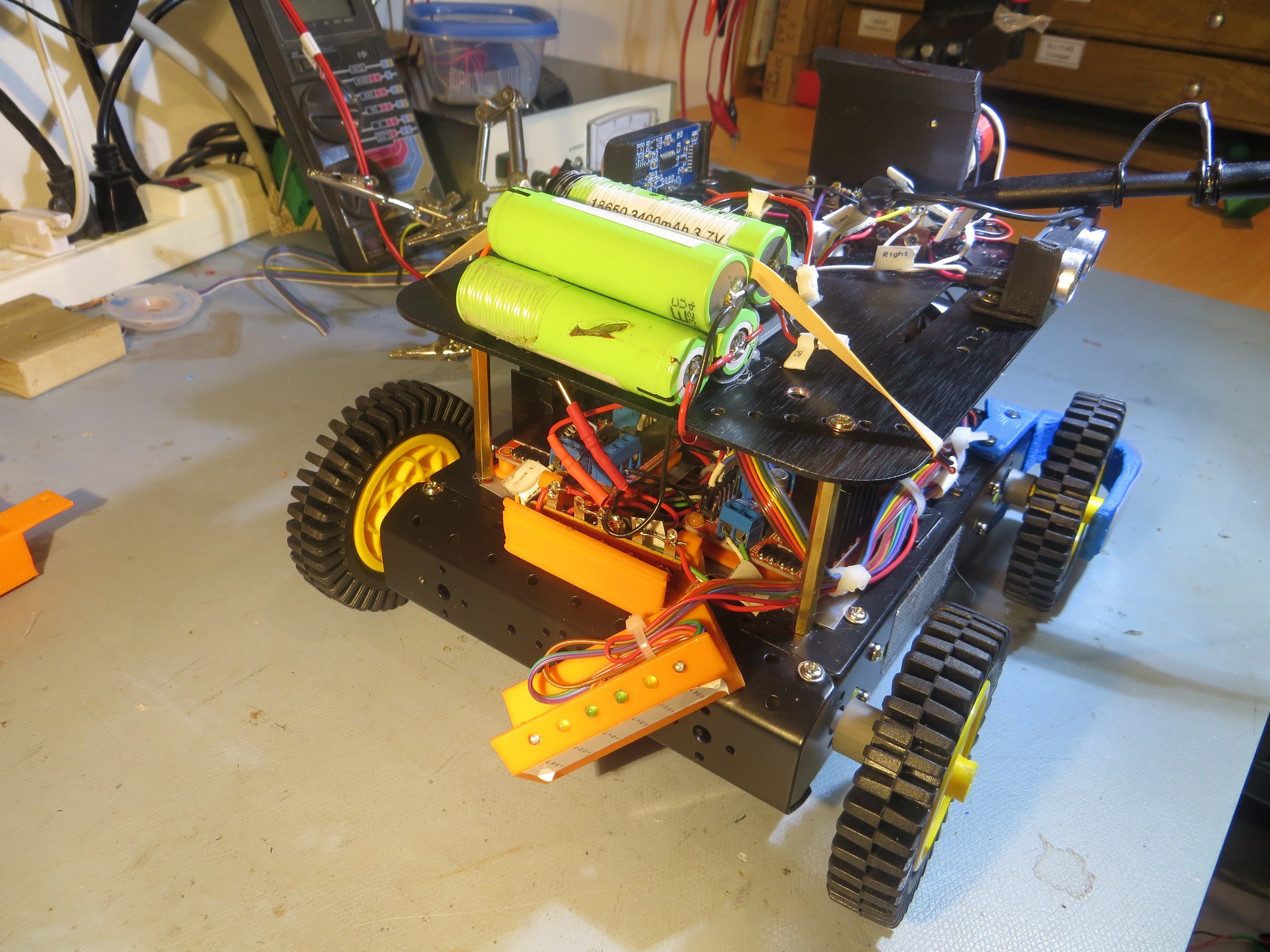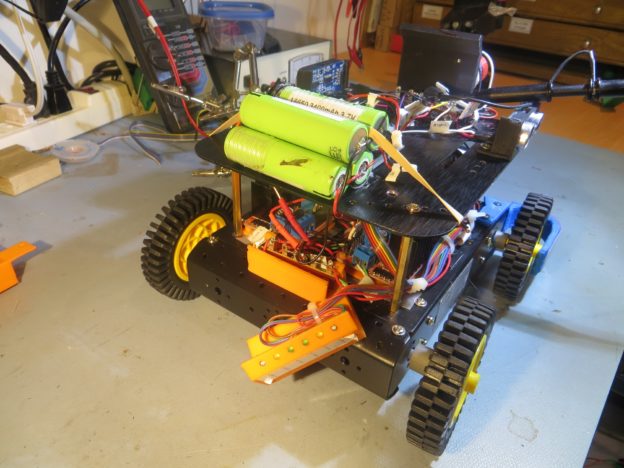Posted 21 February 2018
In early January of this year I posted about finishing the integration of my new-improved battery charger & battery pack into my new-improved robot chassis. Between then and now I have been working on getting the new robot chassis mated up with the charging station (the new robot chassis is wider, and I also changed to larger diameter wheels) in preparation for renewed field testing.
Unfortunately, just as I was getting ready to move into field testing, my robot started acting funny. About half the time, it wouldn’t disengage from the charging station and instead would reboot. At first I thought the added weight of the new battery pack and robot chassis was causing the motors to stall, so I changed the code to have the robot disconnect at full motor speed rather than 1/2 as before. This made the problem even worse; now not only wouldn’t Wall-E2 disengage from the charger, it wouldn’t even move forward or backward under it’s own power! Clearly something was badly wrong, but I had no clue what it was.
Applying my time-honored troubleshooting – I simply put Wall-E2 aside for a few days and let my subconscious work backwards through all the changes since Wall-E2 had last worked properly. After enough time had elapsed, my subconscious reported back and said:
“You are an idiot. All of the complexity you added in your quest for an on-board charging system has placed that wonderful high-capacity battery pack at the far end of a long series of (relatively) high resistance circuitry, and the IR drop caused by full-speed motor currents is killing you!” “Oh, and by the way, you’re ugly too!”
Well, my subconscious is almost never wrong, and it only took me a little bit of testing to confirm it’s theory. I set the code up to go forward and backward at full speed, and monitored the CPU’s 5V regulated output line with my trusty oscilloscope. As soon as the motor command was executed, the 5V line drooped to less than 3V, and the CPU rebooted – oops!
So now I knew what was happening, and I (or my subconscious anyway) had a good idea why. To confirm the why, I bypassed all the charge-management circuitry and wired my 7.4V 7200mAh battery pack directly into the main robot power line, as shown in the photo below

7.4V 7200mAh battery pack wired directly into robot power
With this setup, the robot not only was able to move forward and backward at full speed, the thing damn near took my arm off when I tried to stop it – whoa!
So, the bottom line is that all the work I put in designing and implementing a really cool on-board dual-cell charge management system had the ultimate effect of making the battery unusable. The operation was a success, but the patient died! ;-).
So, where to go from here? It appears that I have to completely revise my thinking about battery charging and maintenance for Wall-E2. Instead of being in series with the battery, any charging/maintenance system must operate in parallel, and be completely out of the path between the battery pack and the load when the robot is running. Now I realize this is the reason most RC/Hobbyist multi-cell battery packs have a balance charging cable in addition to the main power cable; charging is done completely independently of the output path.
When I first started the charger project, my original goal was to avoid having to remove the battery from the robot to charge it; I wanted Wall-E2 to connect to power and charge itself without human intervention. At the time, I felt the only way to do this was to have the charging circuitry on board, so that only a single DC connection from the charging station was required. I thought the only way to make this happen was to use two of the Adafruit SBC1000 charger modules to charge each of the two cells independently. Unfortunately, the SBC1000’s grounds aren’t isolated, so this meant that I had to disconnect the two battery pack cells from each other to charge them independently and then switch them back together again to run the robot after charging. This worked (rather elegantly if I do say so myself), but had the unintended side-effect of putting too much high-loss circuitry and wiring between the battery pack and the motors.
Now that it is clear that I can’t interfere with the current path to the motors, I know I have to abandon the current charging module design, but what are the alternatives?
- The TP5100 is a little module that can balance charge a 2-cell LiPo stack at 2A. It has a dual-color LED output that I might be able to use for charge termination. Unfortunately, the specs are all in Chinese, so it may take some experimentation to figure out.
- I can use an external balance charger like the EV Peak e4 ‘cube’ automatic balance charger, and feed the three required wires (ground, B1+, B2+) out through the front of the robot to the charging station. This solves the problem of carrying the charger around, but significantly complicates the interface to the charging station.
Stay tuned!

Pingback: TP5100 2-cell LiPo Charger Module Study - Paynter's Palace